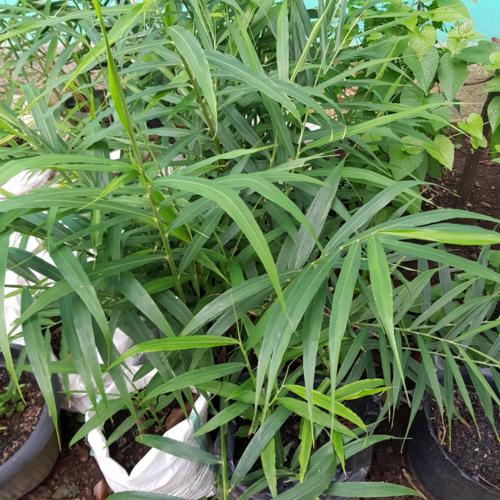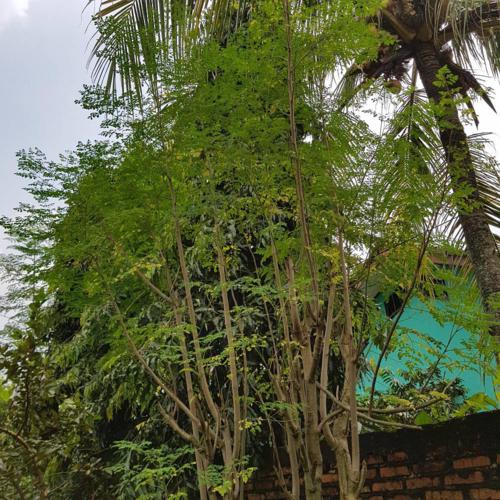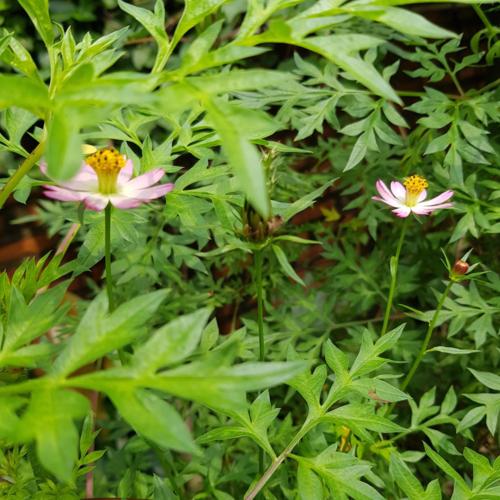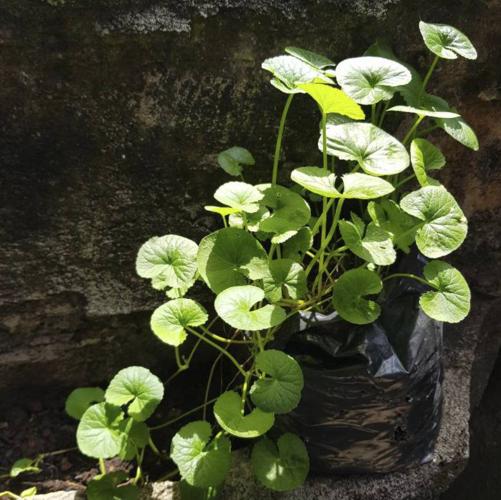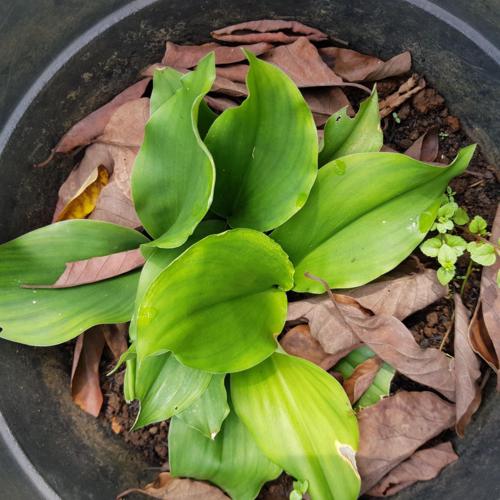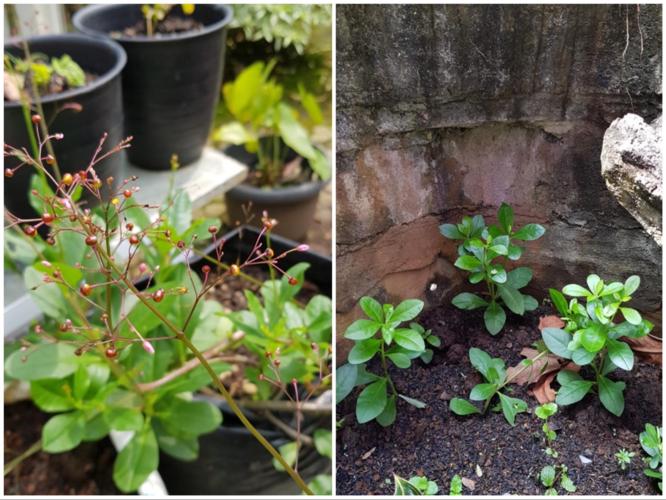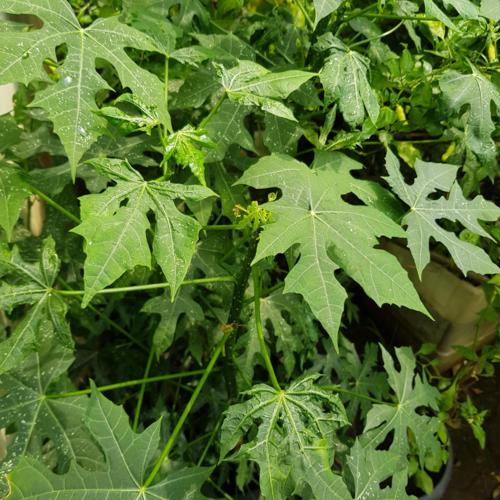March 29, 2021 by yuuki
Beautiful Plants That Don’t Taste That Bad
Zingiber officinale (Ginger)
Ginger, so useful for many kinds of purposes. It makes a good drink on cold days, treats cold symptoms [1], and is used in many kinds of cooking as a spice. I usually have spare ginger that starts sprouting and I feel bad if I don’t grow it. So most of the ginger plants I grow come from kitchen scraps. I use them for cooking, for the most part. I also like to bruise them, then boil in hot water for a warming drink. The spicy effect is caused by gingerol [1]. It is also used as a companion for sushi, as pickled ginger or ‘gari’. I have three ginger varieties, white ginger (Zingiber officinale var officinarum), red ginger (Zingiber officinale var rubrum) and small ginger (Zingiber officinale var. amarumdengan). They have slight differences. The common one, Zingiber officinale var officinarum is the big ginger, it tastes less intense than the small ginger. I use both for traditional Indonesian cooking. Red ginger is incorrectly rumored to have higher medicinal properties, so it’s more expensive. The plants look the same when they grow, although var. rubrum has bigger leaves compared to the others. They also grow well under shade.
Clitoria ternatea (Butterfly pea)
These flowers are called Kembang teleng in Javanese, my tribe language, which means ‘eye flower’ because it is purported to be useful for eye ailments. I don’t know how effective it is as medicine, as this is traditional knowledge that has been passed down through generations instead of scientific knowledge. The flower has a pretty dark blue color and when brewed in hot water, it will dissolve its blue pigment and make a very nicely colored refreshment drink. Even better, it will change to purple when you add lemon juice. The plant is a vine so I need to have a stick for it to climb. It is also very easy to take care of.

Moringa oleifera (Drumstick Tree)
It’s a big tree and its leaves are used for food. It is highly nutritious and could live in areas that are dry and not so fertile, though it fares better in more fertile areas. I don’t usually eat tree leaves, like really, who does? I was skeptical, but the leaves aren’t so bad — they taste like grassy spinach (but, well, what leaves don’t taste like grass, to be honest?) Besides being nutritious, they have many health benefits and contain antioxidants, anticancer, anti-inflammatory, antidiabetic and antimicrobial agents [2]. Moringa oleifera is a perennial plant, so most of the time it has leaves — in a suitable climate. The trees are not beautiful, per se but quite okay as shade trees.
Cosmos caudatus
Cosmos are cute and there are some varieties that are edible. The one that I eat, Cosmos caudatus, has pink-white flowers. They make a good bush. We eat the leaves. The young leaves can be added to salads or eaten straight away. They have a strong taste, I don’t particularly like it but they look nice and always good to have something to eat when I don’t have any vegetables in the fridge. They are basically weeds. They would live and spread their seeds on their own.
Centella asiatica (Pegagan)
I have known about this plant since I lived in West Java during my undergraduate university studies. The area where I lived then has a main tribe, the Sundanese tribe, different from me. They often eat vegetables raw — Centella asiatica is one of the vegetables. Sometimes when I went to the street market vendor, I’d see them. Now, I know that it is edible but could never really get my hands on them. I just got them recently and they are quite nice. They love water and I think they could live on top of water alone, making them a good option for indoor plants. They look like Pilea or nasturtium, in my opinion, with more tender leaves. I could eat them in salad, along with basil. I think they are also used in cosmetics (because I bought something from L’oreal recently that uses Centella asiatica essence and I laughed a bit.)
Crassocephalum crepidioides (Sintrong)
It was a weed, or so I thought. I was displeased when my mom told me to pick these weeds and eat them. I thought, am I some kind of goat/cow to eat this kind of grass? It was when we recently moved house to one that has a bigger backyard. My aunt told me that it was edible, so did an elderly neighbor. It’s called Sintrong, Crassocephalum crepidioides (or Gynura crepidioides — idk why people keep changing names). It was not as bad as I thought, we had it raw with sambal, a chili pepper mix. It doesn’t have any strong taste, just like any grassy raw leaf. As I grew up with a mom who often got stronger tasting vegetables (read: bitter), I didn’t really hate this one. The idea of foraging grew on me and I find it pleasant now. It has quite a nice flower and I am delighted to find these in the backyard.
Kaempferia galanga (Kencur)
Kencur is used in many Indonesian dishes. It is a small rhizome, and requires long years to grow. It has a very strong taste, often described as a mix between ginger and pepper. This aromatic spicy taste comes from the components in the rhizome [4]. It makes a lot of food more tasty, though if it is in raw sauce, I’d recognize the taste and depending on the food, I might avoid it or like it. The leaves are edible and could be used directly for salad. It is a very small plant, you can only see the leaves. But the flower is very cute. Sometimes, when the flower blooms, the leaves are gone for a while, leaving only the white flower directly on the ground, which may be why in India it is called resurrection lily.
Talinum paniculatum (Ginseng Java)
I had eaten this for a while not knowing the effect. A mixture of misunderstanding that it was korean ginseng. This ginseng helps with postpartum contractility [5] and is traditionally said to be good for people after giving birth. Since forming the rhizome takes a long time, I harvest the leaves. The leaves are also edible and it tastes like spinach. I used to put it in my instant noodles to make it ‘healthier.’ The leaves can be eaten directly or cooked. I recently put it in the garden wall/horizontal wall as a plant that blends well with the other ornamental plants.
Cnidoscolus aconitifolius (Pepaya Jepang)
Cnidoscolus aconitifolius are usually used as plants for fences. The leaves look slightly like mini papaya leaves, but I only recently Found out that the young leaves are edible [3], though they have to be cooked for at least 15 minutes to make them safe to eat (they contain cyanogenic glycosides [3]). Pepaya Jepang does not have any connection with Japan as the local name suggests and actually comes from South America, but Indonesian naming sense is not the best. The plants look pretty nice and form good foliage for fences. C. aconitifolius also easily lives in tropical areas.
Carica Papaya (Papaya)
In Indonesia, we not only eat the papaya fruit but also the flowers and leaves. The flowers look pretty good, actually. I know the flowering papaya as ‘pepaya gantung’ or hanging papaya but I just learned very recently, as I researched papaya flowers, that the tree we have is male. I did not know that. The pretty little flowers never bear fruit. Well, now that I know why, it is a male tree, I am enlightened. They usually grow on their own, perhaps brought by bats or birds. In Indonesia, these flowers are harvested, sauteed with garlic, shallots and usually anchovy. They are bitter, just like the leaves.
Papaya trees, apparently, are divided into male trees, female trees and also hermaphroditic trees so they can self pollinate. Nevertheless, we can harvest the leaves and the young papaya for cooking. We use the julienned young papaya and sauté or add coconut milk for curry-like food or wait until they ripen for the papaya fruit that you see in the market.
References
- Bode AM, Dong Z. The Amazing and Mighty Ginger. In: Benzie IFF, Wachtel-Galor S, editors. Herbal Medicine: Biomolecular and Clinical Aspects. 2nd edition. Boca Raton (FL): CRC Press/Taylor & Francis; 2011. Chapter 7. Available from: https://www.ncbi.nlm.nih.gov/books/NBK92775/
- Gopalakrishnan, L., Doriya, K., & Kumar, D. S. (2016). Moringa oleifera: A review on nutritive importance and its medicinal application. Food science and human wellness, 5(2), 49-56. (https://www.sciencedirect.com/science/article/pii/S2213453016300362)
- Cnidoscolus aconitifolius - (Mill.) I.M.Johnst. Retrieved from https://pfaf.org/user/Plant.aspx?LatinName=Cnidoscolus+aconitifolius in March, 2021.
- Srivastava, N., Singh, S., Gupta, A. C., Shanker, K., Bawankule, D. U., & Luqman, S. (2019). Aromatic ginger (Kaempferia galanga L.) extracts with ameliorative and protective potential as a functional food, beyond its flavor and nutritional benefits. Toxicology reports, 6, 521-528.
- Sukwan C, Wray S, Kupittayanant S. The effects of Ginseng Java root extract on uterine contractility in nonpregnant rats. Physiol Rep. 2014;2(12):e12230. Published 2014 Dec 3. doi:10.14814/phy2.12230
